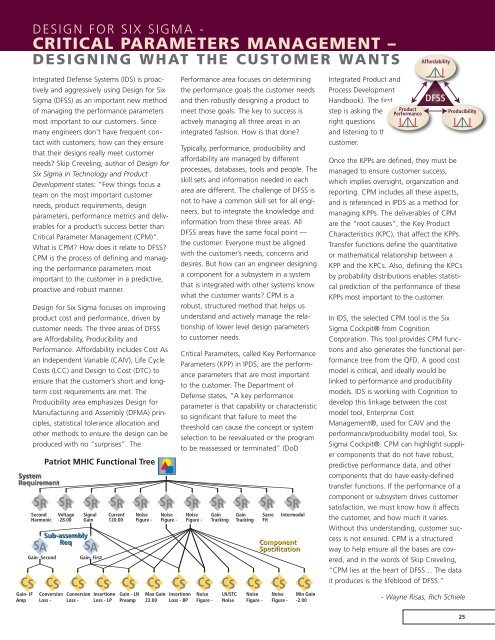TT_Vol3 Issue2 - Raytheon
TT_Vol3 Issue2 - Raytheon
TT_Vol3 Issue2 - Raytheon
Create successful ePaper yourself
Turn your PDF publications into a flip-book with our unique Google optimized e-Paper software.
DESIGN FOR SIX SIGMA -<br />
CRITICAL PARAMETERS MANAGEMENT –<br />
DESIGNING WHAT THE CUSTOMER WANTS<br />
Integrated Defense Systems (IDS) is proactively<br />
and aggressively using Design for Six<br />
Sigma (DFSS) as an important new method<br />
of managing the performance parameters<br />
most important to our customers. Since<br />
many engineers don’t have frequent contact<br />
with customers, how can they ensure<br />
that their designs really meet customer<br />
needs? Skip Creveling, author of Design for<br />
Six Sigma in Technology and Product<br />
Development states: “Few things focus a<br />
team on the most important customer<br />
needs, product requirements, design<br />
parameters, performance metrics and deliverables<br />
for a product’s success better than<br />
Critical Parameter Management (CPM)”.<br />
What is CPM? How does it relate to DFSS?<br />
CPM is the process of defining and managing<br />
the performance parameters most<br />
important to the customer in a predictive,<br />
proactive and robust manner.<br />
Design for Six Sigma focuses on improving<br />
product cost and performance, driven by<br />
customer needs. The three areas of DFSS<br />
are Affordability, Producibility and<br />
Performance. Affordability includes Cost As<br />
an Independent Variable (CAIV), Life Cycle<br />
Costs (LCC) and Design to Cost (DTC) to<br />
ensure that the customer’s short and longterm<br />
cost requirements are met. The<br />
Producibility area emphasizes Design for<br />
Manufacturing and Assembly (DFMA) principles,<br />
statistical tolerance allocation and<br />
other methods to ensure the design can be<br />
produced with no “surprises”. The<br />
Performance area focuses on determining<br />
the performance goals the customer needs<br />
and then robustly designing a product to<br />
meet those goals. The key to success is<br />
actively managing all three areas in an<br />
integrated fashion. How is that done?<br />
Typically, performance, producibility and<br />
affordability are managed by different<br />
processes, databases, tools and people. The<br />
skill sets and information needed in each<br />
area are different. The challenge of DFSS is<br />
not to have a common skill set for all engineers,<br />
but to integrate the knowledge and<br />
information from these three areas. All<br />
DFSS areas have the same focal point —<br />
the customer. Everyone must be aligned<br />
with the customer’s needs, concerns and<br />
desires. But how can an engineer designing<br />
a component for a subsystem in a system<br />
that is integrated with other systems know<br />
what the customer wants? CPM is a<br />
robust, structured method that helps us<br />
understand and actively manage the relationship<br />
of lower level design parameters<br />
to customer needs.<br />
Critical Parameters, called Key Performance<br />
Parameters (KPP) in IPDS, are the performance<br />
parameters that are most important<br />
to the customer. The Department of<br />
Defense states, “A key performance<br />
parameter is that capability or characteristic<br />
so significant that failure to meet the<br />
threshold can cause the concept or system<br />
selection to be reevaluated or the program<br />
to be reassessed or terminated” (DoD<br />
Integrated Product and<br />
Process Development<br />
Handbook). The first<br />
step is asking the<br />
right questions<br />
and listening to the<br />
customer.<br />
Once the KPPs are defined, they must be<br />
managed to ensure customer success,<br />
which implies oversight, organization and<br />
reporting. CPM includes all these aspects,<br />
and is referenced in IPDS as a method for<br />
managing KPPs. The deliverables of CPM<br />
are the “root causes”, the Key Product<br />
Characteristics (KPC), that affect the KPPs.<br />
Transfer functions define the quantitative<br />
or mathematical relationship between a<br />
KPP and the KPCs. Also, defining the KPCs<br />
by probability distributions enables statistical<br />
prediction of the performance of these<br />
KPPs most important to the customer.<br />
In IDS, the selected CPM tool is the Six<br />
Sigma Cockpit® from Cognition<br />
Corporation. This tool provides CPM functions<br />
and also generates the functional performance<br />
tree from the QFD. A good cost<br />
model is critical, and ideally would be<br />
linked to performance and producibility<br />
models. IDS is working with Cognition to<br />
develop this linkage between the cost<br />
model tool, Enterprise Cost<br />
Management®, used for CAIV and the<br />
performance/producibility model tool, Six<br />
Sigma Cockpit®. CPM can highlight supplier<br />
components that do not have robust,<br />
predictive performance data, and other<br />
components that do have easily-defined<br />
transfer functions. If the performance of a<br />
component or subsystem drives customer<br />
satisfaction, we must know how it affects<br />
the customer, and how much it varies.<br />
Without this understanding, customer success<br />
is not ensured. CPM is a structured<br />
way to help ensure all the bases are covered,<br />
and in the words of Skip Creveling,<br />
“CPM lies at the heart of DFSS… The data<br />
it produces is the lifeblood of DFSS.”<br />
- Wayne Risas, Rich Schiele<br />
25
















